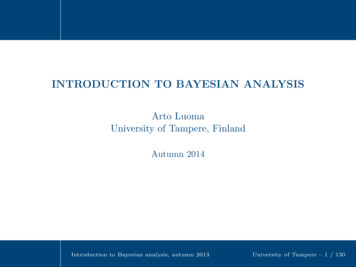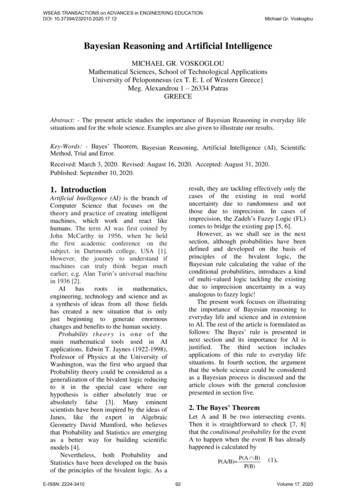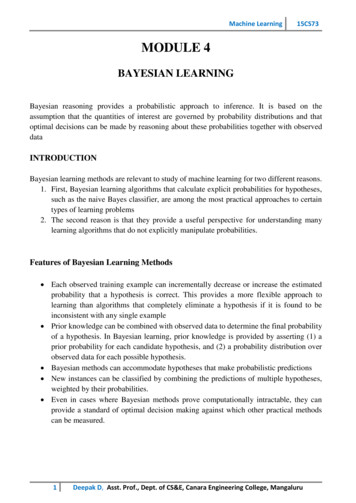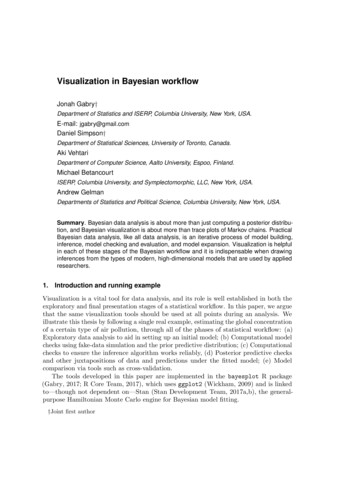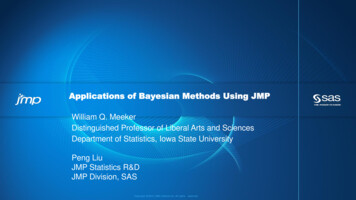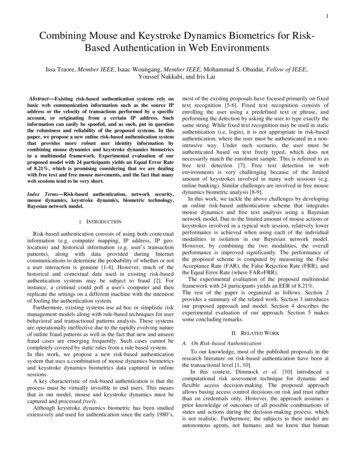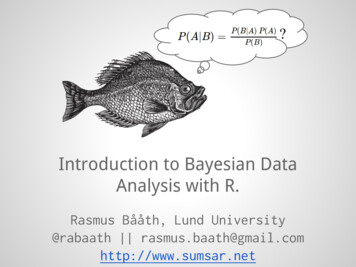
Transcription
Bayesian networks – exercisesCollected by: Jiřı́ Kléma, klema@labe.felk.cvut.czFall 2015/2016Note: The exercises 3b-e, 10 and 13 were not covered this term.Goals: The text provides a pool of exercises to be solved during AE4M33RZN tutorials ongraphical probabilistic models. The exercises illustrate topics of conditional independence,learning and inference in Bayesian networks. The identical material with the resolvedexercises will be provided after the last Bayesian network tutorial.1Independence and conditional independenceExercise 1. Formally prove which (conditional) independence relationships are encoded byserial (linear) connection of three random variables.Only the relationship between A and C shall be studied (the variables connected by an edge are clearlydependent), let us concern A C and A C B:A C P r(A, C) P r(A)P r(C) P r(A C) P r(A) P r(C A) P r(C)A C B P r(A, C B) P r(A B)P r(C B) P r(A B, C) P r(A B) P r(C A, B) P r(C B)It follows from BN definition: P r(A, B, C) P r(A)P r(B A)P r(C B)To decide on conditional independence between A and C, P r(A, C B) can be expressed and factorized.It follows from both conditional independence and BN definition:P r(A, C B) P r(A, B, C)P r(A)P r(B A) P r(C B) P r(A B)P r(C B)P r(B)P r(B)P r(A, C B) P r(A B)P r(C B) holds in the linear connection and A C B also holds.Note 1: An alternative way to prove the same is to express P r(C A, B) or P r(A B, C):1
P r(A, B, C)P r(A)P r(B A)P r(C B) P r(C B) orP r(A, B)P r(A)P r(B A)P r(A, B, C)P r(A)P r(B A)P r(C B)P r(A)P r(B A)P r(C B)PP r(A B, C) P P r(B, C)P r(C B) A P r(A)P r(B A)A P r(A)P r(B A)P r(C B)P r(A)P r(B A) P r(A B)P r(B)P r(C A, B) Note 2: Even a more simple way to prove the same is to apply both the general and the BN specificdefinition of joint probability:P r(A)P r(B A)P r(C A, B) P r(A, B, C) P r(A)P r(B A)P r(C B) P r(C A, B) P r(C B)To decide on independence of A from C, P r(A, C) needs to be expressed. Let us marginalize the BNdefinition:P r(A, C) XP r(A, B, C) B P r(A)XP r(A)P r(B A)P r(C B) P r(A)BXXP r(C B)P r(B A) BP r(C A, B)P r(B A) P r(A)BXP r(B, C A) P r(A)P r(C A)B(the conditional independence expression proved earlier was used, it holds P r(C B) P r(C A, B)).The independence expression P r(A, C) P r(A)P r(C) does not follow from the linear connection andthe relationship A C does not hold in general.Conclusion: D-separation pattern known for linear connection was proved on the basis of BN definition.Linear connection transmits information not given the intermediate node, it blocks the informationotherwise. In other words, its terminal nodes are dependent, however, when knowing the middle nodefor sure, the dependence vanishes.Exercise 2. Having the network/graph shown in figure below, decide on the validity offollowing statements:a) P1 , P5 P6 P8 ,b) P2 P6 ,2
c) P1 P2 P8 ,d) P1 P2 , P5 P4 ,e) Markov equivalence class that contains the shown graph contains exactly three directedgraphs.Solution:a) FALSE, the path through P3 , P4 and P7 is opened, neither the nodes P1 and P6 nor P5 and P6are d-separated,b) FALSE, the path is blocked, namely the node P7 ,c) FALSE, unobserved linear P3 is opened, converging P4 is opened due to P8 , the path is opened,d) FALSE, information flows through unobserved linear P3 ,e) TRUE, P1 P3 direction can be changed (second graph) then P3 P5 can also be changed(third graph).Exercise 3. Let us have an arbitrary set of (conditional) independence relationships amongN variables that is associated with a joint probability distribution.a) Can we always find a directed acyclic graph that perfectly maps this set (perfectly maps preserves all the (conditional) independence relationships, it neither removes noradds any)?b) Can we always find an undirected graph that perfectly maps this set?c) Can directed acyclic models represent the conditional independence relationships ofall possible undirected models?d) Can undirected models represent the conditional independence relationships of all possible directed acyclic models?e) Can we always find a directed acyclic model or an undirected model?Solution:a) No, we cannot. An example is {A C B D, B D A C} in a four-variable problem. This pairof conditional independence relationships leads to a cyclic graph or converging connection whichintroduces additional independence relationships. In practice if the perfect map does not exist, werather search for a graph that encodes only valid (conditional) independence relationships and itis minimal in such sense that removal of any of its edges would introduce an invalid (conditional)independence relationship.b) No, we cannot. An example is {A C } in a three-variable problem (the complementary set ofdependence relationships is {A B , A B C, B C , B C A, A C B}). It follows that Aand B must be directly connected as there is no other way to meet both A B and A B C.The same holds for B and C. Knowing A C , there can be no edge between A and C.Consequently, it necessarily holds A C B which contradicts the given set of independencerelationships (the graph encodes an independence relationship that does not hold).3
c) No, they cannot. An example is the set of relationships ad a) that can be encoded in a form ofundirected graph (see the left figure below), but not as a directed graph. The best directed graphis the graph that encodes only one of the CI relationships (see the mid-left figure below) thatstands for {B D A C}.d) There are also directed graphs whose independence relationships cannot be captured by undirectedmodels. Any directed graph with converging connection makes an example, see the graph on theright in the figure below which encodes the set of the relationships ad b). In the space of undirectedgraphs it needs to be represented as the complete graph (no independence assumptions). Any oftwo of the discussed graph classes is not strictly more expressive than the other.the undirected model ad a)and its imperfect directed counterpartthe directed model ad b)and its imperfect undirected counterparte) No, we cannot. Although the set of free CI relationship sets is remarkably restricted by thecondition of existence of associated joint probability distribution (e.g., the set {A B, B A}violates the trivial axiom of symmetry, there is no corresponding joint probability distribution),there are still sets of relationships that are meaningful (have their joint probability counterpart)but cannot be represented as any graph.Venn diagram illustrating graph expressivity. F stands for free CI relationship sets, P stands for CIrelationship sets with an associated probability distribution, D stands for distributions with the perfectdirected map and U stands for distributions with the perfect undirected map.4
2InferenceExercise 4. Given the network below, calculate marginal and conditional probabilitiesP r( p3 ), P r(p2 p3 ), P r(p1 p2 , p3 ) a P r(p1 p3 , p4 ). Apply the method of inferenceby enumeration.Inference by enumeration sums the joint probabilities of atomic events. They are calculated from thenetwork model: P r(P1 , . . . , Pn ) P r(P1 parents(P1 )) · · · P r(Pn parents(Pn )). The method doesnot take advantage of conditional independence to further simplify inference. It is a routine and easilyformalized algorithm, but computationally expensive. Its complexity is exponential in the number ofvariables.P r( p3 ) XP r(P1 , P2 , p3 , P4 ) P1 ,P2 ,P4XP r(P1 )P r(P2 P1 )P r( p3 P2 )P r(P4 P2 ) P1 ,P2 ,P4 P r(p1 )P r(p2 p1 )P r( p3 p2 )P r(p4 p2 ) P r(p1 )P r(p2 p1 )P r( p3 p2 )P r( p4 p2 ) P r(p1 )P r( p2 p1 )P r( p3 p2 )P r(p4 p2 ) P r(p1 )P r( p2 p1 )P r( p3 p2 )P r( p4 p2 ) P r( p1 )P r(p2 p1 )P r( p3 p2 )P r(p4 p2 ) P r( p1 )P r(p2 p1 )P r( p3 p2 )P r( p4 p2 ) P r( p1 )P r( p2 p1 )P r( p3 p2 )P r(p4 p2 ) P r( p1 )P r( p2 p1 )P r( p3 p2 )P r( p4 p2 ) .4 .8 .8 .8 .4 .8 .8 .2 .4 .2 .7 .5 .4 .2 .7 .5 .6 .5 .8 .8 .6 .5 .8 .2 .6 .5 .7 .5 .6 .5 .7 .5 .2048 .0512 .028 .028 .192 .048 .105 .105 .762.496P r(p2 , p3 ) .6509P r( p3 ).762XXP r(p2 , p3 ) P r(P1 , p2 , p3 , P4 ) P r(P1 )P r(p2 P1 )P r( p3 p2 )P r(P4 p2 ) P r(p2 p3 ) P1 ,P4P1 ,P4 P r(p1 )P r(p2 p1 )P r( p3 p2 )P r(p4 p2 ) P r(p1 )P r(p2 p1 )P r( p3 p2 )P r( p4 p2 ) P r( p1 )P r(p2 p1 )P r( p3 p2 )P r(p4 p2 ) P r( p1 )P r(p2 p1 )P r( p3 p2 )P r( p4 p2 ) .4 .8 .8 .8 .4 .8 .8 .2 .6 .5 .8 .8 .6 .5 .8 .2 .2048 .0512 .192 .048 .4965
P r(p1 , p2 , p3 ).256 .5161P r(p2 , p3 ).496XXP r(p1 )P r(p2 p1 )P r( p3 p2 )P r(P4 p2 ) P r(p1 , p2 , p3 , P4 ) P r(p1 , p2 , p3 ) P r(p1 p2 , p3 ) P4P4 P r(p1 )P r(p2 p1 )P r( p3 p2 )P r(p4 p2 ) P r(p1 )P r(p2 p1 )P r( p3 p2 )P r( p4 p2 ) .4 .8 .8 .8 .4 .8 .8 .2 .2048 .0512 .256P r(p2 , p3 ) P r(p1 , p2 , p3 ) P r( p1 , p2 , p3 ) .256 .24 .496XXP r( p1 , p2 , p3 ) P r( p1 , p2 , p3 , P4 ) P r( p1 )P r(p2 p1 )P r( p3 P2 )P r(p4 P2 ) P4P4 P r( p1 )P r(p2 p1 )P r( p3 p2 )P r(p4 p2 ) P r( p1 )P r(p2 p1 )P r( p3 p2 )P r( p4 p2 ) .6 .5 .8 .8 .6 .5 .7 .2 .192 .048 .24P r(p1 , p3 , p4 ).2328 .4394P r( p3 , p4 ).5298XXP r(p1 , p3 , p4 ) P r(p1 , P2 , p3 , p4 ) P r(p1 )P r(P2 p1 )P r( p3 P2 )P r(p4 P2 ) P r(p1 p3 , p4 ) P2P2 P r(p1 )P r(p2 p1 )P r( p3 p2 )P r(p4 p2 ) P r(p1 )P r( p2 p1 )P r( p3 p2 )P r(p4 p2 ) .4 .8 .8 .8 .4 .2 .7 .5 .2048 .028 .2328P r( p3 , p4 ) P r(p1 , p3 , p4 ) P r( p1 , p3 , p4 ) .2328 .297 .5298XXP r( p1 , p3 , p4 ) P r( p1 , P2 , p3 , p4 ) P r( p1 )P r(P2 p1 )P r( p3 P2 )P r(p4 P2 ) P2P2 P r( p1 )P r(p2 p1 )P r( p3 p2 )P r(p4 p2 ) P r( p1 )P r( p2 p1 )P r( p3 p2 )P r(p4 p2 ) .6 .5 .8 .8 .6 .5 .7 .5 .192 .105 .297Conclusion: P r( p3) 0.762, P r(p2 p3) 0.6509, P r(p1 p2 , p3 ) 0.5161, P r(p1 p3, p4) 0.4394.Exercise 5. For the same network calculate the same marginal and conditional probabilitiesagain. Employ the properties of directed graphical model to manually simplify inferenceby enumeration carried out in the previous exercise.When calculating P r( p3) (and P r(p2 p3) analogically), P4 is a leaf that is not a query nor evidence.It can be eliminated without changing the target probabilities.P r( p3 ) XP1 ,P2P r(P1 , P2 , p3 ) XP r(P1 )P r(P2 P1 )P r( p3 P2 ) P1 ,P2 P r(p1 )P r(p2 p1 )P r( p3 p2 ) P r(p1 )P r( p2 p1 )P r( p3 p2 ) P r( p1 )P r(p2 p1 )P r( p3 p2 ) P r( p1 )P r( p2 p1 )P r( p3 p2 ) .4 .8 .8 .4 .2 .7 .6 .5 .8 .6 .5 .7 .256 .056 .24 .21 .7626
The same result is reached when editing the following expression:P r( p3 ) XP r(P1 , P2 , p3 , P4 ) XP r(P1 )P r(P2 P1 )P r( p3 P2 )P r(P4 P2 ) P1 ,P2 ,P4P1 ,P2 ,P4 XP r(P1 )P r(P2 P1 )P r( p3 P2 )XP1 ,P2P r(P4 P2 ) P4XP r(P1 )P r(P2 P1 )P r( p3 P2 ) 1P1 ,P2Analogically, P r(p2, p3) and P r(p2 p3) can be calculated:P r(p2 , p3 ) XP r(P1 , p2 , p3 ) P1XP r(P1 )P r(p2 P1 )P r( p3 p2 ) P1 P r(p1 )P r(p2 p1 )P r( p3 p2 ) P r( p1 )P r(p2 p1 )P r( p3 p2 ) .4 .8 .8 6 .5 .8 .256 .24 .496The computation of P r(p1 p2 , p3 ) may take advantage of P1 P3 P2 – P2 makes a linear nodebetween P1 and P3 , when P2 is given, the path is blocked and nodes P1 and P3 are d-separated.P r(p1 p2 , p3 ) simplifies to P r(p1 p2 ) which is easier to compute (both P3 and P4 become unqueriedand unobserved graph leaves, alternatively the expression could also be simplified by elimination of thetail probability that equals one):P r(p1 , p2 ).32 .5161P r(p2 ).62P r(p1 , p2 ) P r(p1 )P r(p2 p1 ) .4 .8 .32P r(p1 p2 ) P r(p2 ) P r(p1 , p2 ) P r( p1 , p2 ) .32 .3 .62P r( p1 , p2 ) P r( p1 )P r(p2 p1 ) .6 .5 .3P r(p1 p3 , p4 ) calculation cannot be simplified.Conclusion: Consistent use of the properties of graphical models and precomputation of repetitivecalculations greatly simplifies and accelerates inference.Exercise 6. For the same network calculate P r( p3 ) and P r(p2 p3 ) again. Apply themethod of variable elimination.Variable elimination gradually simplifies the original network by removing hidden variables (those thatare not query nor evidence). The hidden variables are summed out. The target network is the onlynode representing the joint probability P r(Q, e). Eventually, this probability is used to answer the queryP r(Q e) PP r(Q,e)P r(Q,e) .QThe first two steps are the same for both the probabilities: (i) P4 can simply be removed and (ii) P1 issummed out. Then, (iii) P2 gets summed out to obtain P r( p3 ) while (iv) the particular value p3 istaken to obtain P r(p2 p3 ). See the figure below.7
The elimination process is carried out by factors. The step (i) is trivial, the step (ii) corresponds to:fP 1 (P2 ) XP r(P1 , P2 ) P1XP r(P1 )P r(P2 P1 )P1fP 1 (p2 ) .4 .8 .6 .5 .62, fP 1 ( p2 ) .4 .2 .6 .5 .38The step (iii) consists in:fP 1 ,P 2 (P3 ) XfP 1 (P2 )P r(P3 P2 )P2fP 1 ,P 2 (p3 ) .62 .2 .38 .3 .238, fP 1 ,P 2 ( p3 ) .62 .8 .38 .7 .762The step (iv) consists in:fP 1 , p3 (P2 ) fP 1 (P2 )P r( p3 P2 )fP 1 , p3 (p2 ) .62 .8 .496, fP 1 , p3 ( p2 ) .38 .7 .266Eventually, the target probabilities can be computed:P r( p3 ) fP 1 ,P 2 ( p3 ) .762P r(p2 p3 ) fP 1 , p3 (p2 ).496 .6509 fP 1 , p3 (p2 ) fP 1 , p3 ( p2 ).496 .266Conclusion: Variable elimination makes a building block for other exact and approximate inferencealgorithms. In general DAG it is NP-hard, nevertheless it is often “much more efficient” with a properelimination order (it is difficult to find the best one, but heuristics exist). In our example, the enumerationapproach takes 47 operations, the simplified method 17, while the variable elimination method needs 16operations only.Exercise 7. Analyze the complexity of inference by enumeration and variable eliminationon a chain of binary variables.8
The given network factorizes the joint probability as follows:XP r(P1 , . . . , Pn ) P r(P1 )P r(P2 P1 ) . . . P r(Pn Pn 1 )P1 ,.,PnThe inference by enumeration works with up to 2n atomic events. To get the probability of eachevent, n 1 multiplications must be carried out. To obtain P r(pn ), we need to enumerate and sum2n 1 atomic events, which makes (n 1)2n 1 multiplications and 2n 1 1 additions. The inference isapparently O(n2n ).The inference by variable elimination deals with a trivial variable ordering P1 P2 · · · Pn . Ineach step i 1, . . . , n 1, the factor for Pi and Pi 1 is computed and Pi is marginalized out:XP r(Pi 1 ) P r(Pi )P r(Pi 1 Pi )PiEach such step costs 4 multiplications and 2 additions, there are n 1 steps. Consequently, the inferenceis O(n). P r(pn ) (and other marginal and conditional probabilities even easier to be obtained) can becomputed in linear time.The linear chain is a graph whose largest clique does not grow with n and remains 2. That is why,variable elimination procedure is extremely efficient.Exercise 8. For the network from Exercise 4 calculate the conditional probability P r(p1 p2 , p3 )again. Apply a sampling approximate method. Discuss pros and cons of rejection sampling,likelihood weighting and Gibbs sampling. The table shown below gives an output of a uniformrandom number generator on the interval (0,1), use the table to generate 75r190.0155r100.8407r200.6917Let us start with rejection sampling. The variables must be topologically sorted first (current notationmeets the definition of topological ordering, P1 P2 P3 P4 ). The individual samples will begenerated as follows: s1 : P r(p1 ) r1 p1 , s1 : P r(p2 p1 ) r2 p2 , s1 : P r(p3 p2 ) r3 p3 , s1 : P4 is irrelevant for the given prob, s2 : P r(p1 ) r4 p1 , s2 : P r(p2 p1 ) r5 p2 , violates evidence, STOP. s3 : P r(p1 ) r6 p1 ,9
s3 : P r(p2 p1 ) r7 p2 , s3 : P r(p3 p2 ) r8 p3 , violates evidence, STOP. .Using 20 random numbers we obtain 8 samples shown in the table below. The samples s2 , s3 , s4 , s5 ands7 that contradict evidence will be rejected. The rest of samples allows to estimate the target TF?s7FF?s8FTF?P r(p1 p2 , p3 ) 1N (p1 , p2 , p3 ) 0.33N (p2 , p3 )3Likelihood weighting does not reject any sample, it weights the generated samples instead. Thesample weight equals to the likelihood of the event given the evidence. The order of variables and theway of their generation will be kept the same as before, however, the evidence variables will be kept fixed(that is why random numbers will be matched with different probabilities): s1 : P r(p1 ) r1 p1 , w1 : P r(p2 p1 )P r( p3 p2 ) .8 .8 0.64, s2 : P r(p1 ) r2 p1 , w2 : P r(p2 p1 )P r( p3 p2 ) .5 .8 0.4, s3 : P r(p1 ) r2 p1 , w3 : P r(p2 p1 )P r( p3 p2 ) .5 .8 0.4, .Using first 6 random numbers we obtain 6 samples shown in the table below. The target probability isestimated as the fraction of sample weights meeting the condition to their total p5FTF?.40p6FTF?.40PP r(p1 p2 , p3 ) iwi δ(pi1 , p1 ).64P i 0.24 2.64iwConclusion: Both the sampling methods are consistent and shall converge to the target probabilityvalue .5161. The number of samples must be much larger anyway. Rejection sampling suffers from alarge portion of generated and further unemployed samples (see s2 and s6 ). Their proportion grows forunlikely evidences with high topological indices. P r(p1 p3 , p4 ) makes an example. For larger networksit becomes inefficient. Likelihood weighting shall deliver smoother estimates, nevertheless, it suffers fromfrequent insignificant sample weights under the conditions mentioned above.Gibbs sampling removes the drawback of rejection sampling and likelihood weighting. On the otherhand, in order to be able to generate samples, the probabilities P r(Pi M B(Pi )), where M B standsfor Markov blanket of Pi node, must be computed. The blanket covers all Pi parents, children andtheir parents. Computation is done for all relevant hidden (unevidenced and unqueried) variables. Inthe given task, P r(P1 P2 ) must be computed to represent MB of P1 . The other MB probabilities10
P r(P2 P1 , P3 , P4 ), P r(P3 P2 ) and P r(P4 P2 ) are not actually needed (P2 and P3 are evidences andthus fixed, P4 is irrelevant), P r(P3 P2 ) and P r(P4 P2 ) are directly available anyway. However, findingP r(P1 P2 ) itself de facto solves the problem P r(p1 p2 , p3 ). It follows that Gibbs sampling is advantageous for larger networks where it holds i 1 . . . n M B(Pi ) n.Conclusion: Gibbs sampling makes sense in large networks with Pi : M B(Pi ) n, where n standsfor the number of variables in the network.Exercise 9. Let us have three tram lines – 6, 22 and 24 – regularly coming to the stop infront of the faculty building. Line 22 operates more frequently than line 24, 24 goes moreoften than line 6 (the ratio is 5:3:2, it is kept during all the hours of operation). Line 6uses a single car setting in 9 out of 10 cases during the daytime, in the evening it alwayshas the only car. Line 22 has one car rarely and only in evenings (1 out of 10 tramcars).Line 24 can be short whenever, however, it takes a long setting with 2 cars in 8 out of 10cases. Albertov is available by line 24, lines 6 and 22 are headed in the direction of IPPavlova. The line changes appear only when a tram goes to depot (let 24 have its depot inthe direction of IP Pavlova, 6 and 22 have their depots in the direction of Albertov). Everytenth tram goes to the depot evenly throughout the operation. The evening regime is from6pm to 24pm, the daytime regime is from 6am to 6pm.a) Draw a correct, efficient and causal Bayesian network.b) Annotate the network with the conditional probability tables.c) It is evening. A short tram is approaching the stop. What is the probability it will goto Albertov?d) There is a tram 22 standing in the stop. How many cars does it have?Ad a) and b)Which conditional independence relationships truly hold? E N – if not knowing the tram length then the tram number has nothing to do with time. L D N – if knowing the tram number then the tram length and its direction get independent.11
E D N – if knowing the tram number then time does not change the tram direction. E D – if not knowing the tram length then time and the tram direction are independent.Ad c) We enumerate P r(D albertov E evng, L short), the path from E to D is opened (E isconnected via the evidenced converging node L, L connects to unevidenced diverging node N , it holdsD E L, D L ). The enumeration can be simplified by reordering of the variables and elimination ofD in denominator:P r(D albertov, E evng, L short) P r(D albertov E evng, L short) P r(E evng, L short)PP r(E evng, N, L short, D albertov) NP N,D P r(E evng, N, L short, D)PP r(E evng) N P r(N )P r(L short E evng, N )P r(D albertov N )PP P r(E evng) N P r(N )P r(L short E evng, N ) D P r(D N ))PP r(N )P r(L short E evng, N )P r(D albertov N )P NN P r(N )P r(L short E evng, N ) 15 1 11113110 2 10 10 10 5111315 1 2 10 10 5 910 .2548Ad d) In order to get P r(L long N l22), it suffices the information available in nodes E and L,we will only sum out the variable E:XP r(L long N l22) P r(L long, E N l22) E XP r(E N l22) P r(L long E, N l22) E XP r(E) P r(L long E, N l22) E 192 1 .96673 10 3Alternatively, we may simply follow the definition of conditional probability and benefit from two facts:1) the node D is irrelevant as it is an unobserved leaf (which is also blocked by the observed divergingnode L), 2) P r(N l22) can be quickly reduced from the expression, if not it is available directly inthe network too and does not have to be computed. Then:PP r(L long, E, N l22) P r(L long N l22) EP r(N l22)PP r(N l22) E P r(E) P r(L long E, N l22) P r(N l22)X P r(E) P r(L long E, N l22) E192 1 .96673 10 312
Exercise 10. Trace the algorithm of belief propagation in the network below knowingthat e {p2 }. Show the individual steps, be as detailed as possible. Explain in which waythe unevidenced converging node P3 blocks the path between nodes P1 and P2 .Obviously, the posteriorprobabilities are P r (P1 ) P r(P1 p2 ) P r(P1 ), P r (p2 ) 1 and P r (P3 ) P P r(P3 p2 ) P1 P r(P1 )P r(P3 p2 , P1 ) (P r (p3 ) 0.52). The same values must be reached bybelief propagation when message passing stops and the node probabilities are computed as follows:P r (Pi ) αi π(Pi ) λ(Pi ).Belief propagation starts with the following list of initialization steps:1. Unobserved root P1 sets its compound causal π(P1 ), π(p1 ) 0.4, π( p1 ) 0.6.2. Observed root P2 sets its compound causal π(P2 ), π(p2 ) 1, π( p2 ) 0.3. Unobserved leaf P3 sets its compound diagnostic λ(P3 ), λ(p3 ) 1, λ( p3 ) 1.Then, iteration steps are carried out:1. P1 knows its compound π and misses one λ from its children only, it can send πPP31 (P1 ) to P3 :πPP31 (P1 ) α1 π(P1 ) α1 1, πPP31 (p1 ) π(p1 ) 0.4, πPP31 ( p1 ) π( p1 ) 0.62. P2 knows its compound π and misses one λ from its children only, it can send πPP32 (P2 ) to P3 :πPP32 (P2 ) α2 π(P2 ) α2 1, πPP32 (p2 ) π(p2 ) 1, πPP32 ( p2 ) π( p2 ) 03. P3 received all π messages from its parents, it can compute its compound π(p3 ):PQPπ(P3 ) P1 ,P2 P r(P3 P1 , P2 ) j 1,2 πP3j (Pj )π(p3 ) .1 .4 1 .8 .6 1 0.52π( p3 ) .9 .4 1 .2 .6 1 1 P r(p3) 0.48P214. P3 knows its compound λ, misses no π from its parents, it can send λPP3 (P1 ) and λP3 (P2 ):PPQPk6 jλPj3 (Pj ) P3 λ(P3 ) P1 ,P2 P r(P3 P1 , P2 ) k 1,2 πPP3k (Pk )PP1λPλ(P3 ) p1 ,P2 P r(P3 p1 , P2 )πPP32 (P2 ) 1 1(.1 .9) 1P3 (p1 ) PP3PP1λP3 (p2 ) P3 λ(P3 ) P1 ,p2 P r(P3 P1 , p2 )πPP31 (P1 ) 1(.4(.1 .9) .6(.8 .2) 15. P3 knows both its compound parameters, it can compute its posterior P r (P3 ):P r (P3 ) α3 π(P3 )λ(P3 )P r (p3 ) α3 .52 1 .52α3 , P r ( p3 ) α3 .48 1 .48α3 ,P r (p3 ) P r ( p3 ) 1 α3 1, P r (p3 ) .52, P r ( p3 ) .486. P1 receivedQ all of 1its λ messages, the compound λ(P1 ) can be computed:λ(P1 ) j 3 λPPj (P1 )P11λ(p1 ) λPP3 (p1 ) 1, λ( p1 ) λP3 ( p1 ) 113
7. P1 knows both its compound parameters, it can compute its posterior P r (P1 ): P r (P1 ) α4 π(P1 )λ(P1 )P r (p1 ) α4 .4 1 .4α4 , P r ( p1) α4 .6 1 .6α4 ,P r (p1 ) P r ( p1 ) 1 α4 1, P r (p1 ) .4, P r ( p1 ) .6Conclusion: Belief propagation reaches the correct posterior probabilities. The blocking effect of P3manifests in Step 4. Since P3 is a unevidenced leaf, λ(P3 ) has a uniform distribution (i.e., λ(p3 ) λ( p3 ) 1 as P3 is a binary variable). It is easy to Pshow that arbitrary normalized causal messagescoming to P3 cannot change this distribution (it holds Pj πPPjk (Pj ) 1). The reason is that it alwaysPPjholdsP3 P r(P3 P1 , P2 ) 1. Step 4 can be skipped putting λP3 (Pj ) 1 automatically withoutwaiting for the causal parameters.14
3(Conditional) independence tests, best network structureExercise 11. Let us concern the frequency table shown below. Decide about independencerelationships between A and B.ca ab1454 b825 cb b25 567 11The relationships of independence (A B ) and conditional independence (A B C) representtwo possibilities under consideration. We will present three different approaches to their analysis. Thefirst one is based directly on the definition of independence and it is illustrative only. The other twoapproaches represent practically applicable methods.Approach 1: Simple comparison of (conditional) probabilities.Independence is equivalent with the following formulae:A B P r(A, B) P r(A)P r(B) P r(A B) P r(A) P r(B A) P r(B)The above-mentioned probabilities can be estimated from data by maximum likelihood estimation (MLE):6439 0.39, P r(a b) 100 0.64, P r(a) 103P r(a b) 100200 0.513961P r(b a) 103 0.38, P r(b a) 97 0.63, P r(b) 100200 0.5Conditional independence is equivalent with the following formulae:A B C P r(A, B C) P r(A C)P r(B C) P r(A B, C) P r(A C) P r(B A, C) P r(B C)Again, MLE can be applied:822P r(a b, c) 1468 0.21, P r(a b, c) 33 0.24, P r(a c) 101 0.222556P r(a b, c) 32 0.78, P r(a b, c) 67 0.84, P r(a c) 8199 0.825468P r(b a, c) 14 0.64,Pr(b a,c) 0.68,Pr(b c) 0.672279101725 0.31, P r(b a, c) 18 0.39, P r(b c) 32P r(b a, c) 8199 0.32In this particular case it is easy to see that the independence relationship is unlikely, the independenceequalities do not hold. On the contrary, conditional independence rather holds as the definition equalitiesare roughly met. However, it is obvious that we need a more scientific tool to make clear decisions. Twoof them will be demonstrated.Approach 2: Statistical hypothesis testing.Pearson’s χ2 independence test represents one of the most common options for independence testing.A B is checked by application of the test on a contingency (frequency) table counting A and Bco-occurrences (the left table):OABa asumb3961100 b6436100sum10397200EABa asum15b51.548.5100 b51.548.5100sum10397200
The null hypothesis is independence of A and B. The test works with the frequencies expected underthe null hypothesis (the table on right):EAB NA NBN Ea b Na N b103 100 51.5N200The test compares these expected frequencies to the observed ones. The test statistic is:χ2 X (OAB EAB )2 12.51 χ2 (α 0.05, df 1) 3.84EABA,BThe null hypothesis is rejected in favor of the alternative hypothesis that A and B are actually dependentwhen the test statistic is larger than its tabular value. In our case, we took the tabular value for thecommon significance level α 0.05, df is derived from the size of contingency table (df (r 1)(c 1),where df stands for degrees of freedom, r and c stand for the number of rows and columns in thecontingency table). Under the assumption that the null hypothesis holds, a frequency table with theobserved and higher deviation from the expected counts can occur only with negligible probability p 0.0004 α. Variables A and B are dependent.A B C hypothesis can be tested analogically1 . The χ2 test statistic will be separately computed forthe contingency tables corresponding to c and c. The total value equals to sum of both the partialstatistics, it has two degrees of freedom.OABa asumb145468c b82533sum2279101b25732 c b sum568111186799EABa asumb14.853.268c b7.225.833sum2279101b26.25.832 c b54.812.267sum811899The null hypothesis is conditional independence, the alternative hypothesis is the full/saturated modelwith all parameters. The test statistic is:χ2 X (OAB C EAB C )2 0.175 0.435 0.61 χ2 (α 0.05, df 2) 5.99EAB CA,B CThe null hypothesis cannot be rejected in favor of the alternative hypothesis based on the saturatedmodel on the significance level α 0.05. A frequency table with the given or higher deviation fromthe expected values is likely to be observed when dealing with the conditional independence model –p 0.74 α. Variables A and B are conditionally independent given C. Variable C explainsdependence between A and B.Approach 3: Mo
2 Inference Exercise 4. Given the network below, calculate marginal and conditional probabilities Pr(:p 3), Pr(p 2j:p 3), Pr(p 1jp 2;:p 3) a Pr(p 1j:p 3;p 4).Apply the method of inference by enumeration.
